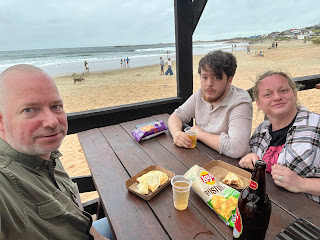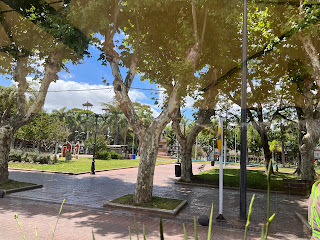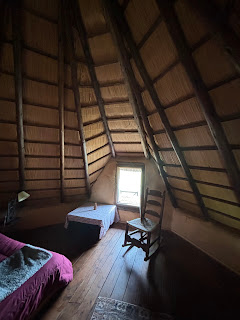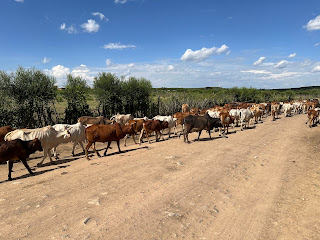For Saturday's breakfast, Lucie had given us a tray of granola, bread, jams, and fruit, the night before. Our cabin had a portable propane burner and an old-style single serving percolator coffee maker to be used with the propane stove. This was the most important item to kick off the day. I quickly got this fired up and cooking.
Lucie knocked on our door at one point and provided us some pourable strawberry yogurt, milk, and fresh fruit as well. We got our selves dressed and enjoyed a quick breakfast while Lucie and her assistants began getting the horses fed and ready for our ride that morning.
 |
| Breakfast in our Cabin |
Once we emerged well fed, she began to brief us on our upcoming ride. She asked what level of equestrian skills we had, and we explained that we are all pretty much novices. She walked through the various commands that the horses were familiar with, emphasizing what she referred to as "zero violence" training for the horses in which there was no kicking involved to get them to begin moving or speed up. Instead the horses responded to an upward brush on their mane to get them to move forward, and other sounds to get them to stop.
 |
| Horses Getting Ready Outside our Kitchen Window |
She selected a horse for each of us. We mounted, and then she lined us all up to head out onto the trails. In addition to Lucie leading us, two of her assistants Alessandra and Nicholas joined us. Alessandra spoke decent English (probably a bit better than my Spanish). Nicholas was learning English and tried very hard to speak it (often with coaching and assistance from Lucie who was trying to help teach him the language), but he was still very early in his learning process.
Lucie led our caravan slowly throughout her property and throughout the local community. She explained that the the residents of that area were all musicians. She pointed out the local bar (which unfortunately I wouldn't be around long enough to sample the craft beers on tap), a building that was intended to be a school (but they didn't have enough children and/or resources to get it off the ground), a small music hall and a few other buildings.
As we ventured further away into the open land away from the community, the trail varied from being anywere to the width of a road, to an extremely narrow trail through brush and trees that swiped at our legs and faces as the horses carried us through.
Alessandra and Aimee who were taking up the rear of the caravan spent much of the time talking (in English). Alessandra was from Brazil but was studying equine veterinarian medicine, and was working with Lucie. When Aimee mentioned we lived in Tennessee, Alessandra shared that her sister was in the US and going to school in Tennessee (ultimately, I believe we determined her sister was in Memphis).
The weather was about perfect for horseback riding as it was in the upper 60s/low 70s (Fahrenheit), cloudy, and an occasional very light drizzle. We continued through open countryside surrounded by hills. The peacefulness of the surrounding Uruguayan countryside was striking. Accompanying the clacking of our horses hooves and the soft instrumental folk guitar music playing from a small speaker Nicholas' was carrying, was a subtle but resounding distant wooshing sound through the trees that amplified the sense of solitude. Though the breeze was light, its resonating sound across the landscape was surprisingly bold. I was captivated. It seemed like something I could listen to for days, and I could immediately understand the allure of a simple gaucho lifestyle. I immediately remembered the experience of sitting in Wadi Rum two years earlier and the same sudden-onset understanding of the allure to the simplicity and serenity of the Bedouin nomadic life in Jordan.
Our path took us over the river twice. The first time the river was only a few inches deep and the horses navigated it with ease. The second time we crossed it at a different spot, the water was about two feet deep. I was amazed at the agility of the horses navigating the rocky bottom of the river in that depth of water. I certainly would have ended up tripping and falling into the river if I navigated it on my own feet.
As we came out on the other side, I began to notice that Zac's horse, which was directly in front of me, seemed to be making a consistent metal "clack" sound with every footstep (as opposed to intermittent and sporadic throughout the beginning of the trip.) I looked down and noticed that I could see the rim of the horse shoe in front of his horse's back left foot. I began checking all of the other horses feet to see if this was normal, and didn't see any other foot where I could see the shoe. I called out to Lucie who was a couple horses up, and told her what I saw.
Lucie asked Nicholas to hop off of his horse and go check it out. Sure enough, half of the shoe had dislodged from the horse's hoof, and it had rotated out in front of the foot. Nicholas pried the other half of the shoe off, and put the shoe in his bag. Aimee asked if the horse would be ok shoeless for the rest of the trip, and Lucie assured us for the short remaining duration he would be fine. Lucie was quite thankful for the catch, as she said the loose shoe could have easily caused the horse to get seriously injured.
About an hour and a half into the trek, Lucie gave us the offer to take a side path up the side of a hill that would bring us to an overlook of the valley, or if we were tiring of the horses, we could head back. We all opted for the extended trip.
This took us up a much steeper path, through much denser brush for 15 minutes or so, but ultimately we arrived at an open outcropping of rock on which we could all gather. We could see miles of the Uruguayan countryside. We took a few photos, and headed back down.
For the last bit of the ride Lucie recommended, if we were comfortable, with a faster gallop for part of the walk back towards the camp. We were willing, and managed our horses with ease. (All credit to the horses, not our own skills).
Once we reached the camp and dismounted from our horses, Lucie suggest we take about 45 minutes to clean up and rest, and lunch would be served.
Lunch was provided in the same cove under the trees as dinner the night before, but this time there were several places set, not only for us, but for Lucie, Alessandra, and Nicholas. In addition to the great vegetarian meal, we shared great conversation with our companions for the morning, bouncing back and forth between English and Spanish. Alessandra had an extremely romantic view of much of the US as cowboys, and rugged men walking around in ten gallon hats and boots. In cities, she had a yearning to experience a meal in an American diner and sipping on a warm cup of coffee.
Unfortunately, as she asked details about these aspects of American life, we inadvertently crushed her dreams by explaining that its really only a few places perhaps in the Southwest where you'll find large ranches with cowboys wandering around like in the old movies, and that for much of the country that is not the case. Additionally, discussing coffee, (as Aimee and I had commented on how good the coffee in Uruguay was, as it was very strong and robust everywhere we had it) she asked if the coffee was not like that in America, particularly in American diners. We had to break it to her that typical restaurant coffee was close to water when compared to the coffee in Uruguay. She told us we were crushing her dreams of American life. We assured here there were some great things to see...but its definitely not all cowboys and good coffee.
As we wrapped up our lunch, Alessandra and Nicholas mentioned there was a community farmer's market that they were going to stop at, and we could follow them on the way out. We thought this sounded like a good idea, so we followed them about a mile up the road. We pulled into a large dirt lot with a few large agricultural looking structures around it, but we didn't see much of a market. When we got out, Alessandra was talking to one of the people there, who explained the market didn't really get going for another couple of hours.
They did have a small convenient store, so we got out and took a look at it, and talked to the husband of the woman running the store. He too was from Europe (Germany) and had lived in many countries when he was young, but fell in love with Uruguay. He did complain about the cost of living in the country, but enjoyed the lifestyle here.
Before we left, I asked if he knew if there was an ATM in Rocha (the nearest city which we would be driving through when we left). He told me yes, there was one on the main plaza. He offered to draw me a map, which I replied "I'm sure I'll be able to find it", but he insisted. He stepped into his house (the entrance of which was to the side of the convenient store), and began rummaging through piles on his table for something to write with. He found a cup full of pencils, and flipped through them, as most did not have a point. He found one with a point, but then was lacking paper. I insisted again I would be fine, but he persisted saying, no I have some paper, one minute. He searched through the room that we were standing in, couldn't find any, and then disappeared into a back room for a minute. I heard rummaging sounds, and he finally reappeared, with a small 4x6 scrap of paper.
On the paper, he drew a large square, on the center of one side, he drew a cross, and said "this is a church" (which was followed by a slight chuckle, assumedly at his artwork). Then he furrowed his brow to think very hard, and said there are two banks, a Canadian one called ScotiaBank, and another one, that everyone calls a BROU. Look for the BROU, it should be over here, and with that he wrote "BROU" on the opposite side of the square from the "Church".
I thanked him for all the assistance, amused as I walked out with the product of 5 minutes of effort resulting in a scrap of paper with nothing more than a cross, a large square, and the word "BROU" on it.
We jumped in the car, and headed over to Rocha, where we did find the ATM, as well as a gas station, and gassed up for the rest of our drive. We were staying the next several nights in Punta del Diablo, but first were going to stop at the Parque Nacional de Santa Teresa. This was a large park on the coast, with a few different historical sites, and most importantly, it was a place that had a lot of capybara. Aimee's highest priority on this trip was to see and/or touch a capybara. We were running a bit late, and it looked like we'd get to the park a little more than an hour before it closed at 6:00pm However, this was the prime time of day to see capybara from what we had been told.
We arrived at the park and had to register our entry, though we were not charged to enter or park. (I'm still not sure if this was by accident or design, as I thought there was an entry fee.) We parked and walk around a bit. There was a small conservatory which we walked through with various plants from all over the world. We spent a few minutes in here as well as wandering the gardens outside, taking in all the sights and admiring the flowers, plants, and trees in the Jardín Uruguayo.
 |
| Parque Nacional de San Teresa Conservatory |

From here, we found a path that led down towards the lagoon, which was where we figured we had the best opportunity to see a capybara. The path led to a narrow boardwalk over a swamp and led to a lookout point on the lagoon.
Upon reaching the lookout, we spotted a couple of very large capybara! Unfortunately, they were on the other side of the lagoon, just hanging around with a couple of large birds, doing what capybara do. We tried to determine if there was a way to easily get to that side of the lagoon, but we did not see a clear path to get there from this side.
 |
| Capybara in the Distance |
As we returned in the direction of the conservatory, we paid much closer attention to our surroundings. We saw what had to be capybara droppings all over, and much of it looked very fresh. There had to be some not too far away. We found it both in the grass near the dirt paths in the gardens as well as on the stone paths around the buildings. We quietly and slowly walked throughout the whole area. But unfortunately, we couldn't find and of them around.
It was near closing time for the entrance to the park. We had only seen a small corner of the park, so we decided to jump in the car and see what else we were missing. There was an old Portuguese fort built in 1762 on the far end of the park, which we had decided to skip since we were going to see a different fort near the city of Chuy the next day. Instead, we drove slowly through all the small roads of the park. Once we got away from the area near the conservatory and other buildings, that much of the rest of the park was a very large campground, with what appeared to be hundreds of campsites over a few square miles of land. Being a holiday weekend at the beginning of South American summer, it was packed with families in tents, people walking around, kids playing games and eating food.
After giving ourselves a quick tour of the grounds, it was closing time (for those not camping overnight) and time for us to leave the park. Our next destination, Punta del Diablo, was conveniently right next to the park. We drove around the corner, and headed down the long central road into the beach town.
Punta del Diablo is a small town full of restaurants, bars, and shops, and hundreds of generally small cabins, houses, and a few small boutique hotels. It would seem the houses in the center part of the city are almost all rental houses. The roads are all dusty dirt roads, and as you get towards the center of town on the beach, the density of restaurants, bars, and people walking around increases dramatically.
We had already had some issues with our lodging. We had rented a small house through AirBNB a few months earlier. When we were heading to the airport to leave for Uruguay however, we received a message saying there was a problem with the water at the house, and they had to cancel. We quickly rebooked into a small hotel, which also had rooms advertised on AirBnB. We knew approximately where it was in the town and drove that direction. As it was a large white three story building with a large thatched roof, surrounded by cabins and small houses, we figured it would be easy to spot. It was called Hotel Diablo.
We found it, but when we pulled up, we noticed the sign over the door said Cuatro Lunas. It seemed very clear that it was the right building, from all the pictures on AirBnB. I realized as we walked in, I never reached out to the AirBNB contact to arrange check in. However, being a hotel, I also figured everything could be arranged at the front desk.
A jovial young man in his early thirties sat behind the desk. As I was expecting for most of the rest of the trip, Spanish would be the only language available to me, and I did my best to let him know that we were checking in, and that we had a reservation through AirBNB. He looked at me a bit strangely and told me that they don't use the AirBnB platform to rent or advertise their rooms. Regardless, he checked the system to see if somehow we were registered as guests, but we were not. I asked if it was possible that they had a long term resident of the hotel that was renting their own room on AirBNB, and he said that was possible. I let him know the name that was the contact on the listing in AirBNB, "Marcelo", but he said he did not know of anyone there by that name. At one point as the conversation was getting more difficult, and I didn't have my translator handy, he pulled up google translate on his computer, and we worked through the more challenging parts of the conversation letting google translate for us.
I tried calling Marcelo's number as listed in the AirBNB listing, but got an automated response that the number couldn't go through. This wasn't looking good.
I asked the young man at the desk if there was a room available if we didn't get the AirBnB thing straightened out, and he said yes.
I called AirBnB, which was fairly responsive and helpful, but their policy was that before they could cancel and refund me for a no-show, they were required to attempt to reach the listing owner, and give them a certain amount of time to respond. In this case they alotted 60 minutes. They told us that for our inconvenience, we could get a $50 reimbursement for dinner while we wait.
 |
| Found the Beach/Waiting for AirBnB |
So we headed down to the beach, found a small shack, and got some food while we waited for a response that we were sure wouldn't come. The beach side shack was closing for the evening, so all they had was the last few empanadas and some other snacks. The weather was still a bit overcast and in the upper 60s. Not quite beach weather at this point, but we sat along side the beach and enjoyed the waves and smell of sea salt. Once the hour had passed and we got confirmation of our refund we went back to the hotel to check in. While the young man took care of our paperwork, a woman in her late 30s met us to show us to our room. For all of his efforts, I gave him a box of Nashville "Goo Goo Clusters" which we generally bring on trips with us to give as gifts to the people we meet around the world. He thanked me gratuitously with a huge smile.
Our room was on the second floor and was a two story room, with a large bed on the first level and a small bed in the loft on the second. Next to our bed were large windows that opened into the room with the ocean in the distance. It was beautiful.
Before the woman left, I asked if there was a remote controller for the AC unit on the wall. She replied something that I didn't understand. I asked her to repeat and I still didn't understand. I attempted to get my electronic translator and fumbled with it while she repeated herself 3 times and I became more flustered as I wasn't understanding her words. She seemed to be getting more annoyed, and I simply said thank you. As soon as she left, I realized she said "Voy a traerlo." Traer is one of the words I always seem to forget the meaning of: "I am going to bring it". The poor girl could have brought it 5 times over in the time I kept asking her what she said.
When she returned with the remote control, I thanked her profusely, and apologized, explaining that I realized what she was telling me as soon as she walked away. She smiled politely.
After dropping off all of our bags, we decided to take a quick tour of the town and find ourselves a full dinner. As we were walking out of the hotel, we met a woman in the lobby who appeared to be the owner of the hotel, probably in her late 50s met us. She spoke English and introduced herself to us. We mentioned we were walking into the town center (about eighth of a mile from the hotel) and she said she would walk with us, as she was going that way as well. She was originally from Austria (same as Lucie) and we had a lovely talk as we got into town. As we approached the town, we could hear drums being played up ahead of us, and she explained it was a traditional Afro-Uruguayan drumming called Candombe. As we got to the edge of the town center, we parted ways and thanked her again.
Now that it was dark, the streets were packed with people and the restaurants and bars as well were buzzing with activity. We walked through a few gift shops and made some purchases, and found ourselves a busy restaurant called ¡Hola Amor!. We grabbed a full dinner, and then returned to our hotel for some much needed sleep.
























































